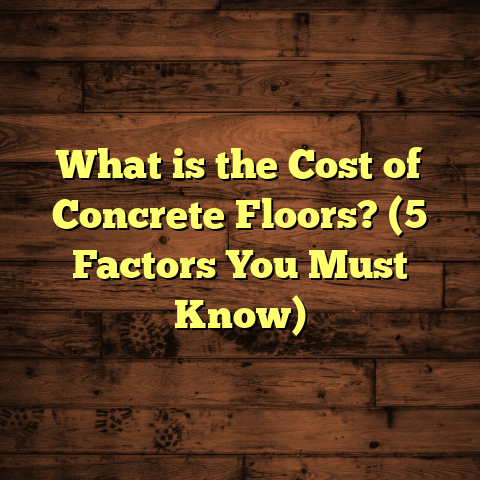What is the Going Rate to Remove a Floor? (5 Key Factors Revealed)
Durability myths around flooring removal have always fascinated me. Many people seem to think once a floor is laid, it’s set in stone—like it’s going to last forever and won’t require much effort or cost to remove down the road. But after many years working closely with floors and homeowners, I’ve learned that’s far from the truth. Floors wear out, materials change, and sometimes you just want something new. And when that time comes, removing an old floor isn’t as straightforward as peeling back a sticker. There’s a lot that goes into it—labor, tools, disposal, and sometimes surprises lurking underneath. So how much does it actually cost to remove a floor? What factors make prices jump or drop? Let me walk you through everything from my hands-on experience and share insights you won’t find just anywhere.
What Is the Going Rate to Remove a Floor?
Removing a floor means taking out the existing flooring material covering your space. You might be pulling up carpeting, tearing out vinyl sheets, chiseling away tile, or prying up hardwood planks. On the surface, it sounds simple: just rip out what’s there. But I assure you, it requires careful work to avoid damaging the underlying subfloor and to prepare the area for whatever comes next.
The “going rate” for floor removal varies widely based on many factors — including where you live, what type of flooring you have, how big the space is, and how complex the removal job will be. Generally speaking, here’s a rough idea:
- Carpet removal: $1 to $2 per square foot
- Vinyl removal: $1 to $3 per square foot
- Hardwood removal (nail-down): $2 to $4 per square foot
- Hardwood removal (glue-down): $3 to $5+ per square foot
- Tile removal: $3 to $6+ per square foot
Keep in mind these numbers are averages. Your exact rate depends on the specifics of your project.
Why does the cost vary so much? Let’s dive deeper.
1. Type of Flooring Material
The kind of flooring you’re removing dramatically impacts the difficulty and cost.
Carpet Removal
Carpet is usually the simplest and cheapest flooring to remove because it generally isn’t glued down. It’s often held in place by tack strips nailed around the edges. Once you cut through carpet seams and pull it free from those strips, most of the work is done. You’ll still need to remove padding underneath if present — sometimes that adds time but usually not too much.
I remember a small condo renovation where we removed carpet from about 700 square feet of living area. The whole job took just a few hours with two workers and cost under $1,000 for removal alone — including hauling away old carpet rolls.
Vinyl Flooring Removal
Vinyl can be tricky depending on how it was installed. Sheet vinyl adhered with glue or vinyl tiles glued down with strong adhesive require scraping and prying with special tools. Older vinyl floors may contain asbestos if installed before the 1980s, so proper testing and abatement are necessary.
In one home I worked on, removing glue-down vinyl from a kitchen required several hours of scraping and chemical softening agents before we could lift up sheets without damaging the subfloor. That pushed costs higher than simple peel-up vinyl.
Hardwood Floor Removal
Hardwood floors come in different installation styles:
- Nail-Down Hardwood: Boards are nailed into wood subfloors and can be pried up relatively easily with pry bars and nail pullers. This method is less labor-intensive.
- Glue-Down Hardwood: Boards are glued directly onto concrete or plywood subfloors. This can be a nightmare to remove because the adhesive bonds tightly.
I’ve pulled up many nail-down hardwood floors where boards came up almost in one piece and were reusable if desired. But glue-down hardwood required power scrapers and lots of elbow grease — sometimes taking double the time.
Tile Removal
Tile is often the most expensive and laborious floor type to remove. Ceramic or porcelain tile is set with mortar on concrete or plywood subfloors, plus grout fills between tiles.
Removing tile means breaking each tile apart with jackhammers or heavy chisels, then scraping off mortar residue afterward. It’s loud, dusty work that takes time and skill to avoid damaging the subfloor underneath.
For example, I removed 500 square feet of ceramic tile from a kitchen once, and labor costs alone approached $2,000 due to how stubbornly the tile adhered.
2. Size of the Area
How big your floor area is significantly influences total cost — but not always in a linear way.
Small Spaces vs Large Spaces
Small rooms might cost more per square foot because setup time and disposal fees don’t scale down easily. A 50-square-foot bathroom might cost $3–$6 per square foot for tile removal due to tight spaces and detailed work around cabinetry.
Larger spaces sometimes benefit from economies of scale. For instance, removing flooring from a sprawling 2,000-square-foot commercial building may bring rates closer to $1.50 per square foot because the crew works efficiently over large areas and cleanup/disposal trips are consolidated.
I once tackled a retail space that was 5,000 square feet with vinyl floors throughout. Because we had continuous open space and easy access, removal took less time per square foot than smaller residential jobs.
How Does Size Affect Disposal?
Big projects generate more waste — more carpet rolls or wood planks to haul away. Disposal fees might be charged by volume or weight at landfills or recycling centers.
This means large jobs require budgeting for multiple debris hauls or renting dumpsters for longer periods.
3. Condition of the Existing Floor
The state of your current floor can make a huge difference in removal complexity and price.
Well-Maintained vs Damaged Floors
If your floor is intact with no damage beneath, removal is relatively straightforward and faster.
But if there’s water damage, mold growth, rot, or layers of old flooring stacked on top of each other (like carpet over vinyl over wood), expect higher costs.
In one project I managed, after pulling up vinyl flooring we discovered plywood subflooring was rotted through due to years of leaks. We had to tear out damaged plywood sections and replace them before installing new floors — adding days of work and extra material expenses.
Hidden Surprises
Old adhesive residues can slow progress when removing glue-down floors. Some adhesives harden over decades making scraping tedious.
In another job involving glue-down hardwood, we encountered asbestos-containing adhesive under the boards requiring certified abatement services — which added thousands in testing and specialized removal fees.
4. Labor Costs in Your Area
Where you live impacts labor rates significantly.
Urban vs Rural
City centers like New York or San Francisco typically have higher labor costs due to elevated living expenses. Rates of $75+ per hour for skilled flooring crews aren’t uncommon.
Smaller towns or rural areas might see rates as low as $40 per hour for similar work.
DIY Considerations
Some homeowners attempt DIY floor removal to save money — especially with carpet or peel-and-stick vinyl.
It’s doable if you have basic tools like utility knives, pry bars, scrapers, gloves, knee pads, and patience.
But DIY risks include damaging subfloors (leading to costly repairs) or exposure to dust/dangerous materials without proper protection.
5. Disposal Fees and Environmental Regulations
Throwing away old flooring isn’t always as simple as loading it into your trash bin.
Waste Regulations
Many municipalities have strict rules about disposing construction debris like flooring materials.
If your floor has asbestos-containing tiles (common before 1980s), professional testing is required followed by special disposal procedures handled by licensed contractors.
Landfill Costs
Disposal fees vary based on weight or volume at local landfills or recycling centers. Some charge flat fees; others base pricing on tons hauled away.
In one project removing old carpet from a 1,200-square-foot house, disposal fees were nearly $500 because we made multiple trips hauling heavy padding rolls.
How I Use Tools Like FloorTally for Cost Estimation
Accurate budgeting has always been important in my work — both for myself and my clients. Early on, I used manual calculations based on local labor rates plus materials estimates which could become confusing quickly with so many variables.
That’s why I started using FloorTally — an online tool that consolidates local material prices, labor costs, waste factors, and disposal fees into one neat package.
It lets me input specific details like square footage, floor type (carpet, tile, hardwood), waste percentages (to account for cutting or damage), local labor rates, and even disposal charges based on location data.
For example: During a recent project removing 1,000 sq ft of glue-down hardwood in a suburban area with moderately high labor costs ($60/hr), FloorTally gave me a clear cost breakdown in minutes instead of hours crunching numbers manually.
It also helps me visualize how changing variables affect total price — like switching from tile to laminate flooring afterward or adjusting crew size for faster completion.
While I don’t rely solely on any tool blindly (nothing replaces real-world experience), FloorTally has become an invaluable part of my estimating process because it reduces guesswork and improves client trust through transparent quotes.
Deep Dive: Real Project Cost Breakdown Examples
Here are some detailed examples based on projects I’ve personally handled:
Case Study 1: Carpet Removal in a Duplex Apartment
- Size: 800 sq ft
- Floor Type: Wall-to-wall carpet with padding
- Labor: Two workers completed job in under 4 hours
- Disposal: Carpet rolled & hauled off by crew
- Cost: Approximately $1,200 total ($1.50/sq ft)
Because carpet was in good condition (no glue or staples beyond tack strips) removal was quick and clean — perfect for tenant turnover renovation.
Case Study 2: Kitchen Tile Removal Followed by Hardwood Installation
- Size: 300 sq ft
- Floor Type: Ceramic tile glued over concrete slab
- Labor: Two workers over 3 days (including mortar scraping)
- Disposal: Paid $350 for debris hauling
- Additional: Subfloor repair after tile removal
- Total Cost: Around $1,700 ($5.67/sq ft)
The adhesive bonding was tough; extra care was needed near cabinets to prevent damage. Subfloor repairs added unexpected expenses but were necessary for quality new floor installation.
Case Study 3: Glue-Down Hardwood Removal Before Laminate Flooring Installation
- Size: 1,000 sq ft
- Floor Type: Glue-down engineered hardwood
- Labor: Three workers over two days using scrapers & heat guns
- Disposal: Included in project budget using local recycling center
- Cost Estimate Using FloorTally: <del>$4,500 total (</del>$4.50/sq ft)
Using FloorTally helped me provide a precise quote upfront — clients appreciated knowing potential extra costs from disposal or labor variations before signing contracts.
Frequently Asked Questions About Floor Removal Costs
Q: Can I remove floors myself?
Yes! Carpet and some peel-up vinyl are doable DIY projects if you have basic tools and patience. But tougher floors like glued hardwood or tile usually require professional help due to equipment needs and risk of damage.
Q: How long does floor removal typically take?
Small rooms can take a few hours; larger spaces several days depending on material type and condition.
Q: What should I do after removing my old floor?
Inspect your subfloor carefully for damage or rot. Repairs may be necessary before installing new flooring materials.
Q: Are there hidden costs I should watch out for?
Definitely! Disposal fees, subfloor repairs, asbestos testing (for old vinyl/tile), and unexpected adhesive removal can add up quickly if not planned for.
Wrapping Up My Thoughts on Floor Removal Pricing
I’ve seen firsthand how many variables impact the cost of removing an old floor — from what type of material you’re dealing with to how big your space is to local labor market conditions and waste disposal fees.
If you’re thinking about removing floors soon:
- Measure your area accurately.
- Identify what kind of flooring you have.
- Research local labor rates.
- Consider condition issues like water damage.
- Factor in disposal costs.
- Use tools like FloorTally to get quick budget estimates.
Understanding these points helps you avoid surprises later and plan your renovation more confidently.
If you want me to help break down your project specifics or share insights on what new floors might work best following removal, just ask anytime!
Feel free to tell me if you want me to add specific sections such as safety tips during floor removal, environmental impacts of flooring waste, or detailed comparisons of removal methods by material type!





